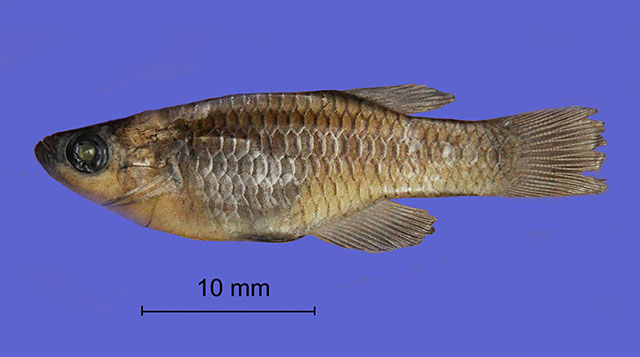|
Dorsal spines (total): 0-0; Dorsal soft rays (total): 9-10; Anal spines: 0-0; Anal soft rays: 15-16. Diagnosis: Hypsopanchax stiassnyae is distinguished from deep-bodied Hylopanchax species by its diverging supra-orbital cephalic sensory system versus parallel in Hylopanchax; it is distinguished from deep-bodied Plataplochilus species by its open supra-orbital cephalic sensory system versus a tubular system with large pores; it is distinguished from Procatopus and the northern Hypsopanchax, H. catenatus, H. platysternus and H. zebra, and Platypanchax modestus by the supra-orbital cephalic sensory system lacking a zigzag structure (Ref. 103403). Hypsopanchax differs from Hylopanchax and Plataplochilus by the lack of branchiostegal appendages in males (Ref. 103403). Hypsopanchax stiassnyae differs from H. jubbi by the shorter snout, 3.3-3.7% of standard length vs. 4.5-5.7%, the shorter anterior part of the supra-orbital cephalic sensory system, 36.5% of length of supra-orbital sensory system vs. 53.2, the absence of well developed lobes bordering the grooves of the supra-orbital sensory system, and a lower number of circumpeduncular scales, 10 vs. 11-12; it is distinguished from H. jobaerti by a straight dorsal profile vs. a convex profile, with relatively longer neural spines 6-11 in H. jobaerti, a shorter dorsal and anal fin base in females, dorsal fin base 11.8-12.1% of standard length vs. 13.2-13.8, anal fin base 15.2-16.3% of standard length vs. 16.8-19.0, and in males unpaired fins completely dark grey vs. only the distal edge of unpaired fins with dark pigmentation; in addition, they can be distinguished by a less deep body, especially in females, males 27.9-32.5% of standard length vs. 31.5-39.3, females 27.7-29.1% of standard length vs. 30.0-32.9, and slightly lower number of anal-fin rays, males 15-16 vs. 16-18, females 15 vs. 16-18 (Ref. 103403).
Description: A small Hypsopanchax species, laterally strongly compressed; dorsal profile straight, slightly concave at nape; greatest body depth between pelvic and anal fins; ventral profile convex from head to end of anal fin; snout rounded, mouth directed upwards; lower jaw longer than upper jaw; on both jaws an outer row of larger, slightly curved conical teeth, inner teeth row more irregular arranged with smaller teeth; no branchiostegal appendages in adult males (Ref. 103403). Four very small frontal or nasal neuromasts present, pre-orbital cephalic sensory canal with 4 pores; post-orbital canal with 2 pores; open groove of supra-orbital neuromast system split in two parts with large neuromasts and narrow lobes; pre-opercular neuromast system with 5 pores, some of them elongated; lobes of supra-temporal neuromast system prominent (Ref. 103403). Scales cycloid, body completely scaled except ventral head surface, one row of large scales underneath eye, frontal squamation of G-type, no scales on dorsal- and anal-fin bases, scales on mid longitudinal series 26-28 (Ref. 103403). Number of dorsal-fin rays 9-10, anal-fin rays 15-16; first dorsal-fin ray above anal-fin ray 7-8 (Ref. 103403).
Colouration: No information on live colouration available (Ref. 103403). Preserved in ethanol: males with back brown and flanks light brown, a narrow whitish band just above pelvic fin widening above anal fin; all flank scales with dark margins, forming a reticulated pattern; snout dark brown to blackish; pectoral fin translucent with dark tip, pelvic fin dark grey to blackish, unpaired fins dark grey (Ref. 103403). Females as males, less black pigmentation on flanks, whitish band on ventral side broader, pectoral fin translucent without dark edge, all other fins grayish (Ref. 103403). |

